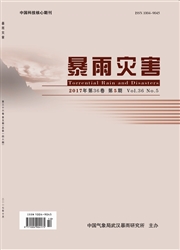

 中文摘要:
中文摘要:
2008年7月14—15日,四川盆地西部“5.12”汶川大地震重灾区在非典型热力条件下出现了一次暴雨天气过程。本文利用常规观测资料和NCEP 1°×1°再分析资料,对其天气形势及温度层结变化特征进行了详细分析。结果表明:(1)暴雨发生在副热带高压不断西伸的环流背景下,低层偏南气流及其风速脉动对暴雨产生具有重要作用。(2)暴雨开始于850hPa以下降及大气层结为弱稳定的非典型热力条件下,但700hPaθse突增使得700-500hPa对流性不稳定层建立,从而利于对流运动发展;暴雨过程后期,因850hPa和700hPaθse急剧下降和大气层结稳定度增大,对流上升受到明显抑制。(3)低层θse锋区和水汽辐合对强降水具有指示意义,暴雨落区位于850hPa和700hPaθse锋区前沿,降水中心位于水汽汇合中心附近。
 英文摘要:
英文摘要:
Using conventional observational data and NCEP global 1°×1°final-analysis data, the synoptic situation and temperature stratification changing of the rainstorm which occurred on the a typical thermal condition in the worst-hit area of "5.12" Wenchuan earthquake in the western Sichuan basin on July 14-15, 2008 are analyzed in detail. It is shown that the rainstorm occurs in the circulation of the subtropical high constantly westward extending. The low-level southern air current and the wind velocity fluctuation are keys to the rainstorm generation. The rainstorm begins under the θse reducing at 850 hPa and the weak stable atmospheric stratification, but the 700 hPa θse increase linearly results in the convective instability from 700 to 500 hPa, which leads to the convective motion; due to θse rapidly reducing at the 850 hPa and 700 hPa and the atmospheric stability enhancing, the convection upward motion is restrained in the last period of the rainfall process. The low-level frontal zone of θse and water vapor convergence are good significances for rainfall. The rainstorm fields are in the front edge of the frontal zone of the pseudo-equivalent potential temperature at 700 hPa and 850 hPa. The rain center is located in the water vapor convergence center.
 同期刊论文项目
同期刊论文项目
 同项目期刊论文
同项目期刊论文
 期刊信息
期刊信息
